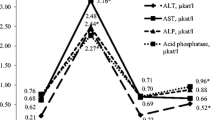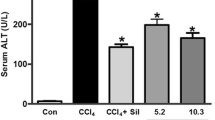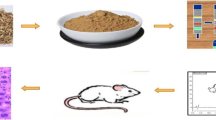Abstract
The aim of the present study was to evaluate the hepatoprotective, antioxidant, and anti-inflammatory potential of chebulagic acid on carbon tetrachloride–induced hepatic fibrosis in rats. The liver was damaged in the rats using CCL4 (2 ml/kg b.w dissolved in 20% corn oil) intragastrically twice/week for 8 weeks. After 8 weeks, activities of serum aspartate aminotransferase, alanine aminotransferase, alkaline phosphatase and lactate dehydrogenase, lipid peroxidation markers, and enzymic and non-enzymic antioxidant enzymes, inflammatory and anti-inflammatory cytokines were analyzed and all these parameters were altered. Chebulagic acid administration reversed all the altered parameters to near-normal levels. Improved histological and immunohistochemical observations liver supported the biochemical investigated. Hence, chebulagic acid exhibits hepatoprotective effects against CCl4-induced liver damage.





Similar content being viewed by others
References
Baker H, Frank O, Angelis B, Feingold S (1980) Plasma tocopherol in man at various times after ingesting free or acetylated tocopherol. Nutr Rep Int 21:531–536
Jalali Ghassam B, Ghaffari H, Prakash HS, Kini KR (2014) Antioxidant and hepatoprotective effects of Solanum xanthocarpum leaf extracts against CCl4-induced liver injury in rats. Pharm Biol 52(8):1060–1068
Chen X, Ying X, Zhang W, Chen Y, Shi C, Hou Y, Zhang Y (2013) The hepatoprotective effect of fraxetin on carbon tetrachloride induced hepatic fibrosis by antioxidative activities in rats. Int Immunopharmacol 17:543–547
Elgawish RAR, Rahman HGA, Abdelrazek HMA (2015) Green tea extract attenuates CCl4-induced hepatic injury in male hamsters via inhibition of lipid peroxidation and p53-mediated apoptosis. Toxicol Rep 2:1149–1156
Ellman GL (1959) Tissue sulfhydryl groups. Arch Biochem Biophys 82:70–77
Frei B, Higdon JV (2003) Antioxidant activity of tea polyphenols in vivo: evidence from animal studies. J Nutr 133(10):3275–3284
Fu Y, Zheng S, Lin J, Ryerse J, Chen A (2008) Curcumin protects the rat liver from CCl4-caused injury and fibrogenesis by attenuating oxidative stress and suppressing inflammation. Mol Pharmacol 73:399–409
Gao H, Huang YN, Xu P, Kawabata YJ (2007) Inhibitory effect on a-glucosidase by the fruits of Terminalia chebula Retz. Food Chem 105:628–634
Ghatak S, Biswas A, Dhali GK, Chowdhury A, Boyer JL, Santra A (2011) Oxidative stress and hepatic stellate cell activation are key events in arsenic induced liver fibrosis inmice. Toxicol Appl Pharmacol 251:59–69
Habig WH, Pabst MJ, Jakoby WB (1974) Glutathione-S-transferase: the first step in mercapturic acid formation. J Biol Chem 249:7130–7139
Hamada S, Kataoka T, Woo JT, Yamada A, Yoshida T, Nishimura T, Otake N, Nagai K (1997) Immunosuppressive effects of gallic acid and chebulagic acid on CTLmediated cytotoxicity. Biol Pharm Bull 20:1017–1019
Iredale J (2008) Defining therapeutic targets for liver fibrosis: exploiting the biology of inflammation and repair. Pharmacol Res 58:129–136
Jaramillo-Juarez F, Rodriguez-Vazquez ML, Rincon-Sanchez AR, Consolacion M, Martinez GG, Ortiz J, Reyes JL (2008) Caffeic acid phenethyl esteragainst carbon tetrachloride toxicity in rats. Ann Hepatol 7:331–338
Jiang ZY, Hunt JV, Wolff SP (1992) Ferrous ion oxidation in the presence of xylenol orange for detection of lipid hydroperoxide in low density lipoprotein. Anal Biochem 202:384–387
Kinoshita S, Inoue Y, Nakama S, Ichiba T, Aniya Y (2007) Antioxidant and hepatoprotective actions of medicinal herb, Terminalia catappa L. from Okinawa Island and its tannin corilagin. Phytomedicine 14:755–762
Latief U, Ahmad R (2018) Herbal remedies for liver fibrosis: a review on the mode of action of fifty herbs. J Tradit Complement Med 8:352–360
Lee SI, Hyun PM, Kim SH, Kim KS, Lee SK, Kim BS, Maeng PJ, Lim JS (2005) Suppression of the onset and progression of collagen-induced arthritis by chebulagic acid screened from a natural product library. Arthritis Rheum 52:345–353
Liu C, Tao Q, Sun M, Wu JZ, Yang P, Jian Peng J, Hu Y, Liu C, Liu P (2010) Kupffer cells are associated with apoptosis, inflammation and fibrotic effects in hepatic fibrosis in rats. Lab Invest 90:1805–1816
Liu W, Shang P, Liu T, Xu H, Ren D, Zhou W, Wen A, Ding Y (2017) Gastroprotective effects of chebulagic acid against ethanol-induced gastric injury in rats. Chem Biol Int 278:1–8
Lowry OH, Rosebrough NJ, Farr AL, Randall RJ (1951) Protein measurement with folinphenol reagent. J Biol Chem 193:265–275
Murakami A, Ishida HK, Furukawa K, Ikeda I, Yonaha Y, Aniya M, Ohigashi YH (2005) Suppressive effects of Okinawan food items on free radical generation from stimulated leukocytes and identification of some active constituents: implications for the prevention of inflammation-associated carcinogenesis. Asian Pac J Cancer Prev 6:437–448
Niehius WG, Samuelsson D (1968) Formation of malondialdehyde from phospholipids arachidonate during microsomal lipid peroxidation. Eur J Biochem 6:26–130
Novo E, Parola M (2008) Redox mechanisms in hepatic chronic wound healing and fibrogenesis. Fibrogenesis Tissue Repair 1(44):247–256
Ogeturk M, Kus I, Colakoglu N, Zararsiz I, Ilhan N, Sarsilmaz M (2005) Caffeic acidphenethyl ester protects kidneys against carbon tetrachloride toxicity in rats. J Ethnopharmacol 97:273–280
Omaye ST, Turnbull TD (1979) Sauberlich. H.E. Selected method for the determination of ascorbic acid in animal cells, tissues and fluid. In: McCormic DB, Wright DL (eds) Methods Enzymol, vol 62. Academic Press, New York, pp 3–11
Rotruck JT, Pope AL, Ganther HE, Swanson AB, Hafeman DG, Hoekstra WG (1973) Selenium: biochemical role as a component of glutathione peroxidase. Science 179:588–590
Sambrook J, Fritsch EF, Maniatis T (1989) Molecular cloning: a laboratory manual. 2nd ed. Cold Spring Harbor, NY, Cold Spring Harbor Laboratory Press
Sinha KA (1972) Colorimetric assay of catalase. Anal Biochem 47:389–394
Stringer MD, Gorog PG, Freeman A, Kakkar VV (1989) Lipid peroxides and atherosclerosis. Br Med J 298:281–284
Weber LWD, Boll M, Stampfl A (2003) Hepatotoxicity and mechanism of action of haloalkanes: carbon tetrachloride as a toxicological model. Crit Rev Toxicol 33:105–136
Zhang LJ, Yu JP, Li D, Huang YH (2004) Effects of cytokines on carbon tetrachlorideinduced hepatic fibrogenesis in rats. World J Gastroenterol 10:77–81
Funding
The authors are thankful to the DST-SERB ECR project, New Delhi, India, for providing financial assistance to purchase chebulagic acid for performing this work.
Author information
Authors and Affiliations
Corresponding author
Ethics declarations
Ethical approval
The experimental protocol was approved by the Ministry of Social Justices and Empowerment, Government of India, and Institutional Animal Ethics Committee Guidelines (IAEC No: No. 12/09/2016).
Informed consent
All authors are consented to publish this manuscript in this journal.
Conflict of interest
The authors declare no competing interests.
Additional information
Publisher's Note
Springer Nature remains neutral with regard to jurisdictional claims in published maps and institutional affiliations.
Rights and permissions
About this article
Cite this article
Sundaram, R., Ganesh, V., Nandhakumar, E. et al. Hepatoprotective and anti-inflammatory potential of chebulagic acid on carbon tetrachloride–induced hepatic fibrosis by antioxidative activities in rats. Comp Clin Pathol 30, 961–971 (2021). https://doi.org/10.1007/s00580-021-03295-0
Received:
Accepted:
Published:
Issue Date:
DOI: https://doi.org/10.1007/s00580-021-03295-0




